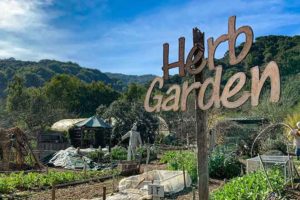
Summary:
When visiting a garden it’s fun to use all five senses to explore. There are six plant parts that plants, animals, and humans need. The compost pile helps to recycle nutrients from plant matter back into the garden.
Know-It-All
1. What are the 6 plant parts? What does each part do to help the plant?
2. Give examples of how Nicole used her five senses in the garden. How do you use your five senses to explore the world outside?
3. What do plants need to survive?
4. Not all of the plants in the garden are used to feed people. What other purposes do plants have?
5. The garden is all about cycles. At the end of the video Nicole gave some finished compost (with its many nutrients) back to the garden. Explain this cycle and which organisms are working on breaking down our left over food and other plant wastes.
6. We often talk about how our surrounding wilderness helps the garden grow. Can you think of a few ways that our wild neighbors can help support the garden? For example, bees and butterflies help to pollinate the flowers in the garden so we can enjoy the fruit in the fall. How might a bird help our garden?
What about a lizard?
Digging Deeper
• Enjoy this song about the garden: https://youtu.be/y1oiVEWFHrs
• How do plants create their own food energy (in the form of simple sugars)? Watch this video to learn about that process, known as photosynthesis – https://youtu.be/68b1HAIfX08 .
• Pollinators: Bees are probably the most important pollinators in the garden. Do a little research. All around the world, bees are having a difficult time right now! What are some of the major
threats facing bee populations? What can you do to help?
Try It
A. Interview a Plant!
Find an interesting plant in your immediate area and “interview it”. This could be a plant you find outside, or your favorite house plant. Write down your observations. Try to find as many of the six plant parts as possible. These are: roots, stems, leaves, flowers, fruit and seeds. What kind of shape do the leaves have? Are they hanging out in groups or is each leaf separate? Are they completely green or are there other colors? How about the stems? Are they thick or thin? What color or colors are they? Does the
plant have flowers? Are there any holes or cuts in your plant that may have been made by an animal? What else do you notice? Make a sketch to record your observations and add labels with arrows to your sketch, to point out key details. This is what scientists do so they can share
observations with others.
After about 15 minutes of your own observations, introduce your interviewed plants to another person, and show them your drawing. Challenge them to find the plant you interviewed based on your
description.
B. Build-a-plant!
Now that you know the six plant parts, you can create your own plant. Gather one example of each plant part from your refrigerator or from a plant outside. Be gentle and ask permission before taking a part off of a living plant. Lay the parts out to form a whole, new plant! Take a picture and share it with a friend, or maybe even send it to us at [email protected]!
Draw a plant using your imagination! Be as creative as possible. Use bright colors or interesting shapes – whatever you want. Be sure to include all six plant parts!
C. Blind Taste Test
Can you find these six plant parts in your fridge? Ask an adult to help you with a blind taste test by collecting as many of the six plant parts as you have available today. Using a bandana to block your vision, taste each of the parts and describe them to your adult helper. What did they smell, feel, and taste like? Can you guess all of the parts?
Print out the guide by downloading the PDF
#307 Student Guide